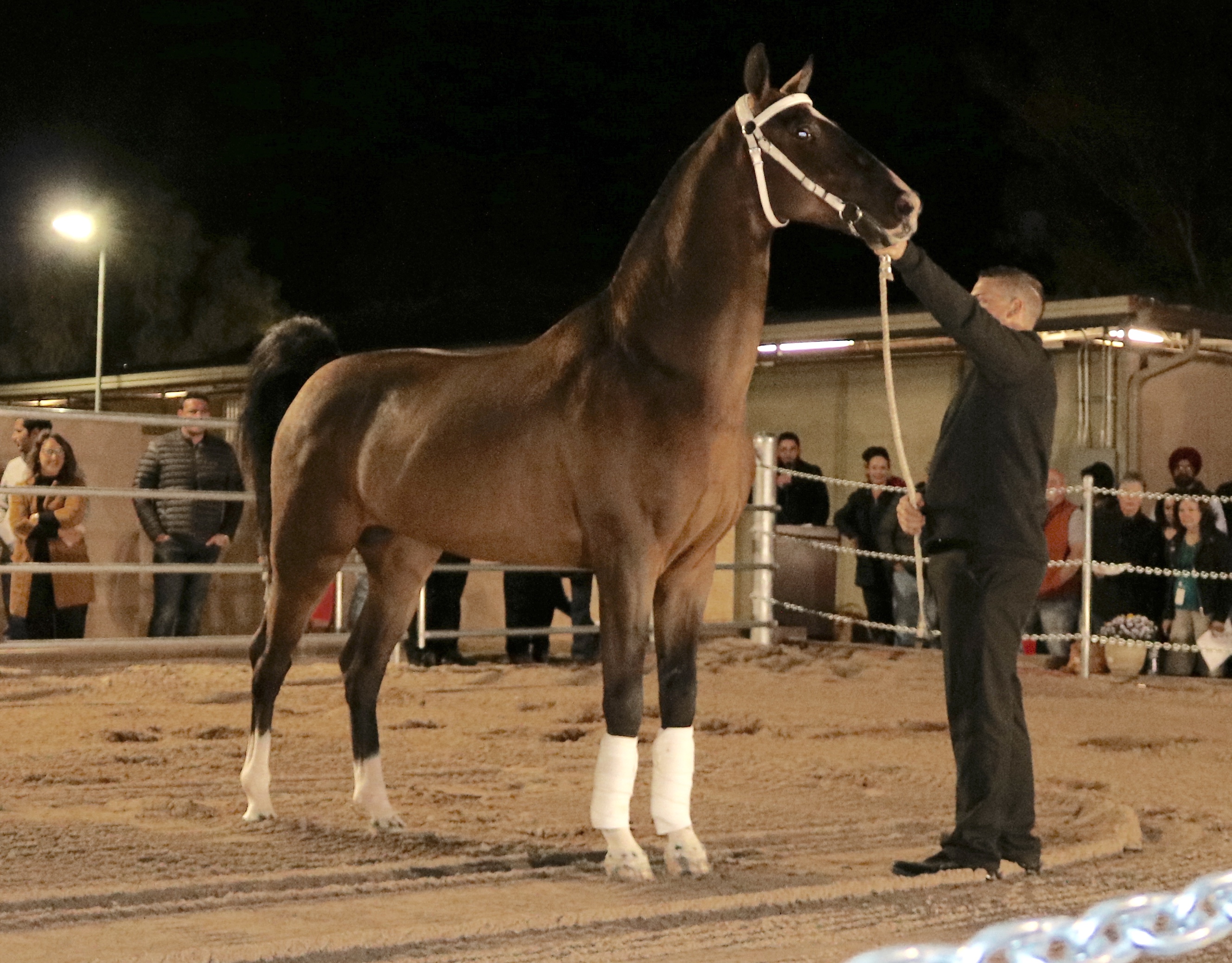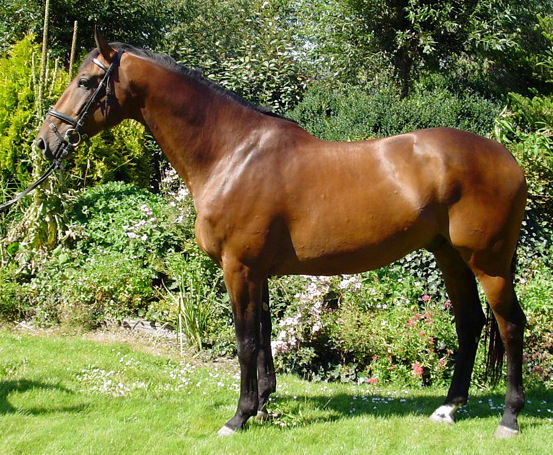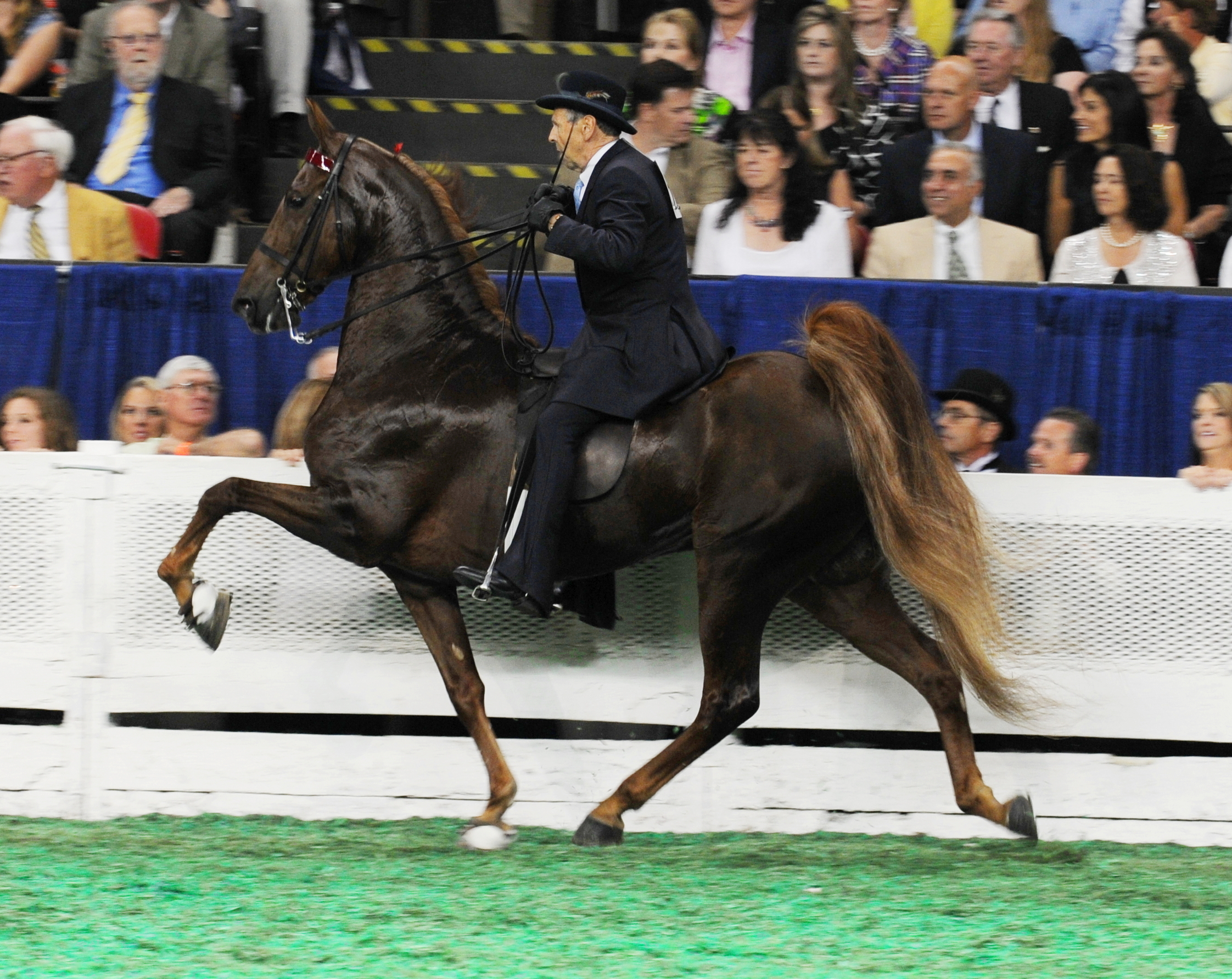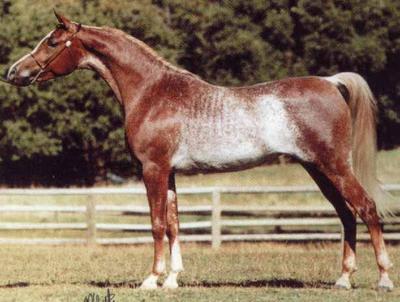|
Dutch Harness Horse
The Dutch Harness Horse, or Tuigpaard, is a warmblood breed of fine driving horse that has been developed in the Netherlands since the end of World War II. Their studbook is kept by the Koninklijk Warmbloed Paardenstamboek Nederland (Royal Warmblood Horse Studbook of the Netherlands) or KWPN. The breed is based on the native Groningen and Gelderland horses, which were formerly indispensable in agriculture and transportation services. Strict selection procedures and a clear breeding aim enabled breeders to produce a refined, high-stepping horse within a few decades. While with 40 sires and fewer than 2,000 broodmares the population is not large, Dutch Harness Horses are highly recognizable. In the past few years, a handful have come to North America, where they are used as sport horses and saddle seat horses alike. Characteristics The Dutch Harness Horse is distinctive among warmbloods for its high action, and gaining popularity among those saddle seat aficionados who seek a l ... [...More Info...] [...Related Items...] OR: [Wikipedia] [Google] [Baidu] |
Warmblood
Warmbloods are a group of middle-weight horse types and breeds primarily originating in Europe and registered with organizations that are characterized by open studbook policy, studbook selection, and the aim of breeding for equestrian sport. The term distinguishes these horses from both heavy draft horses ("cold bloods") and refined light saddle horses such as the Thoroughbred, Arabian, and Akhal-Teke ("hot bloods"). Although modern warmbloods are descended from heavier agricultural types systematically upgraded by hotblood influence, the term does not imply that warmbloods are direct crosses of "cold" and "hot". Breeding policies Open studbook policies separate most warmbloods from true "breeds" such as Thoroughbreds, Arabians, Percherons, and Morgans which have a closed stud book and require two purebred parents. Instead, most warmblood registries accept breeding stock from other similar populations to continuously improve their own, and do not consider their own hor ... [...More Info...] [...Related Items...] OR: [Wikipedia] [Google] [Baidu] |
Black (horse)
Black is a hair coat color of horses in which the entire hair coat is black. Black is a relatively uncommon coat color, and it is not uncommon to mistake dark chestnuts or bays for black. True black horses have dark brown eyes, black skin, and wholly black hair coats without any areas of permanently reddish or brownish hair. They may have pink skin beneath any white markings under the areas of white hair, and if such white markings include one or both eyes, the eyes may be blue. Many black horses "sun bleach" with exposure to the elements and sweat, and therefore their coats may lose some of their rich black character and may even resemble bay or seal brown, though examination of the color of hair around the eyes, muzzle and genitals often will determine color. Black horses that do not sun bleach are called "non-fading" blacks. Some breeds of horses, such as the Friesian horse, Murgese and Ariegeois (or Merens), are almost exclusively black. Black is also common in the F ... [...More Info...] [...Related Items...] OR: [Wikipedia] [Google] [Baidu] |
Dutch Warmblood
A Dutch Warmblood is a warmblood type of horse registered with the Koninklijk Warmbloed Paardenstamboek Nederland (Royal Warmblood Studbook of the Netherlands (KWPN), which governs the breeding of competitive dressage and show jumping horses, as well as the show harness horse and Gelderlander, and a hunter studbook in North America. Developed through a breeding program that began in the 1960s, the Dutch are some of the most successful competition horses developed in postwar Europe. History Prior to World War II, there were two types of utility horse in the Netherlands: Gelderlanders bred in the south under the Gelderlander Horse Studbook (1925) and the Groningen bred in the north under the NWP (1943). The Groningen was, and still is, a heavy-set warmblood horse very similar to the Alt-Oldenburger and East Friesian. The Gelderlander was a more elegant variation, often serving as a carriage horse in addition to a useful draft horse. While the Groningen were almost unwave ... [...More Info...] [...Related Items...] OR: [Wikipedia] [Google] [Baidu] |
Trot (horse Gait)
The trot is a ten-beat diagonal horse gait where the diagonal pairs of legs move forward at the same time with a moment of suspension between each beat. It has a wide variation in possible speeds, but averages about . A very slow trot is sometimes referred to as a jog. An extremely fast trot has no special name, but in harness racing, the trot of a Standardbred is faster than the gallop of the average non-racehorse, and has been clocked at over . On June 29, 2014, at Pocono Downs in Pennsylvania the Swedish standardbred Sebastian K trotted a mile in 1 minute, 49 seconds (quarters were passed at 26:2, 55:3 and 1,21:4). This is equivalent to a 1000-pace in 1.07,7 or 53.14 kilometers per hour or 33 miles per hour. From the standpoint of the balance of the horse, the trot is a very stable gait and does not require the horse to make major balancing motions with its head and neck.Harris, Susan E. ''Horse Gaits, Balance and Movement'' New York: Howell Book House 1993 pp. 35–37 Due ... [...More Info...] [...Related Items...] OR: [Wikipedia] [Google] [Baidu] |
Canter
The canter and gallop are variations on the fastest gait that can be performed by a horse or other equine. The canter is a controlled three-beat gait, while the gallop is a faster, four-beat variation of the same gait. It is a natural gait possessed by all horses, faster than most horses' trot, or ambling gaits. The gallop is the fastest gait of the horse, averaging about . The speed of the canter varies between depending on the length of the horse's stride. A variation of the canter, seen in western riding, is called a lope, and is generally quite slow, no more than . Etymology Since the earliest dictionaries there has been a commonly agreed suggestion that the origin of the word "canter" comes from the English city of Canterbury, a place of pilgrimage in the Middle Ages, as referred to in '' The Canterbury Tales'', where the comfortable speed for a pilgrim travelling some distance on horseback was above that of a trot but below that of a gallop. However a lack of compel ... [...More Info...] [...Related Items...] OR: [Wikipedia] [Google] [Baidu] |
American Saddlebred
The American Saddlebred is a horse breed from the United States. This breed is referred to as the "Horse America Made". Descended from riding-type horses bred at the time of the American Revolution, the American Saddlebred includes the Narragansett Pacer, Canadian Pacer, Morgan and Thoroughbred among its ancestors. Developed into its modern type in Kentucky, it was once known as the "Kentucky Saddler", and used extensively as an officer's mount in the American Civil War. In 1891, a breed registry was formed in the United States. Throughout the 20th century, the breed's popularity continued to grow in the United States, and exports began to South Africa and Great Britain. Since the formation of the US registry, almost 250,000 American Saddlebreds have been registered, and can now be found around the world, with separate breed registries established in Great Britain, Australia, continental Europe, and southern Africa. Averaging in height, Saddlebreds are known for their sen ... [...More Info...] [...Related Items...] OR: [Wikipedia] [Google] [Baidu] |
Tobiano
Tobiano is a spotted color pattern commonly seen in pinto horses, produced by a dominant gene. The tobiano gene produces white-haired, pink-skinned patches on a base coat color. The coloration is almost always present from birth and does not change throughout the horse's lifetime, unless the horse also carries the gray (horse), gray gene. It is a dominant gene, so any tobiano horse must have at least one parent who carries the tobiano gene. Other spotting patterns seen in pinto horses include Overo#Frame_overo, frame overo, splashed white and sabino horse, sabino. In the United Kingdom, tobianos are frequently referred to as "coloured" or as "pied": piebald if black and white, skewbald if white and any base color other than black. Sometimes "painted" is also used. Bay (horse), Bay and white tobiano horses are also referred to as Tricoloured (horse), tricoloured. Characteristics Tobiano traits generally include the following: * White legs from the hocks and knees down * White ... [...More Info...] [...Related Items...] OR: [Wikipedia] [Google] [Baidu] |
Rabicano
Rabicano, sometimes called white ticking, is a horse coat color characterized by limited roaning in a specific pattern: its most minimal form is expressed by white hairs at the top of a horse's tail, often is expressed by additional interspersed white hairs seen first at the flank, then other parts of the body radiating out from the flank, where the white hairs will be most pronounced. Rabicano is distinct from true roan, which causes evenly interspersed white hairs throughout the body, except for solid-colored head and legs. Etymology The word, "rabicano" is of Spanish origin - ''rabo'' meaning "tail" and ''cano'' meaning "white" - thus, it described a horse with white hairs in its tail.Juan de la Cruz Puig. ''Antologia de Poetas Argentinos,''1910. pg. 131. "Rabicano: caballo que tiene cerdas blancas á la raíz de la cola." abicano: a horse that has white hairs at the root of the tail/ref> The word appears very early in epic poems in Italian literature: Argalia, a characte ... [...More Info...] [...Related Items...] OR: [Wikipedia] [Google] [Baidu] |
Sabino Horse
A sabino horse with extensive roaning Sabino describes a distinct pattern of white spotting in horses. In general, Sabino patterning is visually recognized by roaning or irregular edges of white markings, belly spots, white extending past the eyes or onto the chin, white above the knees or hocks, and "splash" or "lacy" marks anywhere on the body. Some sabinos have patches of roan patterning on part of the body, especially the barrel and flanks. Some sabinos may have a dark leg or two, but many have four white legs. Sabino patterns may range from slightly bold face or leg white markings—as little as white on the chin or lower lip—to horses that are fully white. The known causes of the sabino patterns are the SB-1 allele and several other dominant white (W) alleles on the ''KIT'' gene. The genetics behind some types of sabino, such as that found in Clydesdales, have not yet been identified. Some genes, such as Sabino-1, are incomplete dominants, producing irregular spot ... [...More Info...] [...Related Items...] OR: [Wikipedia] [Google] [Baidu] |
Cream Gene
The cream gene is responsible for a number of horse coat colors. Horses that have the cream gene in addition to a base coat color that is chestnut will become palomino if they are heterozygous, having one copy of the cream gene, or cremello, if they are homozygous. Similarly, horses with a bay base coat and the cream gene will be buckskin or perlino. A black base coat with the cream gene becomes the not-always-recognized smoky black or a smoky cream. Cream horses, even those with blue eyes, are not white horses. Dilution coloring is also not related to any of the white spotting patterns. The cream gene (''CCr'') is an incomplete dominant allele with a distinct dosage effect. The DNA sequence responsible for the cream colors is the cream allele, which is at a specific locus on the solute carrier family 45 member 2 (''SLC45A2'') gene (previously known as ''MATP'' and ''OCA4'', among others). Its general effect is to lighten the coat, skin and eye colors. When one copy of ... [...More Info...] [...Related Items...] OR: [Wikipedia] [Google] [Baidu] |
Roan (horse)
Roan is a horse coat color pattern characterized by an even mixture of colored and white hairs on the body, while the head and "points"—lower legs, mane, and tail—are mostly solid-colored. Horses with roan coats have white hairs evenly intermingled throughout any other color. The head, legs, mane, and tail have fewer scattered white hairs or none at all. The roan pattern is dominantly inherited, and is found in many horse breeds. While the specific mutation responsible for roan has not been exactly identified, a DNA test can determine zygosity for roan in several breeds. True roan is always present at birth, though it may be hard to see until after the foal coat sheds out. The coat may lighten or darken from winter to summer, but unlike the gray coat color, which also begins with intermixed white and colored hairs, roans do not become progressively lighter in color as they age. The silvering effect of mixed white and colored hairs can create coats that look bluish o ... [...More Info...] [...Related Items...] OR: [Wikipedia] [Google] [Baidu] |








